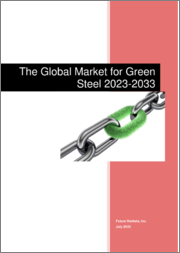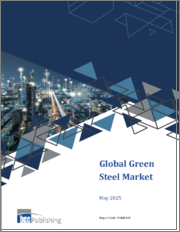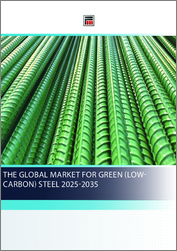
|
시장보고서
상품코드
1315038
세계의 그린 스틸 시장(2023-2033년)The Global Market for Green Steel 2023-2033 |
||||||
세계 그린 스틸 시장이 확대되고 있으며, 티센크루프(Thyssenkrupp AG)는 최근 독일 정부로부터 그린 스틸 생산 계획에 대해 20억 유로의 국고 보조금을 받았습니다. 많은 주요 철강업체들이 그린 스틸 전략과 대규모 생산을 계획하고 있으며, 2033년까지 비용 절감과 정책적 인센티브가 결합되어 그린 스틸이 2억 3,000만 톤을 넘어설 것으로 예상됩니다.
이 보고서는 세계 그린 스틸 시장에 대해 조사 분석했으며, 시장 동향과 촉진요인, 최근 산업 동향과 기술 혁신, 시장 수익과 전망, 기업 개요 등을 전해드립니다.
목차
제1장 조사 방법
제2장 두문자어 리스트
제3장 서론
- 현재 제강 프로세스
- 그린 스틸이란 무엇인가?
- 탈탄소화 목표와 정책
- 클린 생산 기술 진보
- 생산 기술
- 특성
- 그린 스틸의 첨단 재료
- 복합 전극
- 고체 산화물 재료
- 수소 저장 금속
- 탄소 복합 강
- 코팅, 멤브레인
- 지속가능한 결합재
- 철광석 촉매
- 탄소 포집 재료
- 폐가스 이용
- 그린 스틸의 장단점
- 시장과 용도
제4장 세계의 그린 스틸 시장
- 세계의 철강 생산
- 철강 가격
- 그린 스틸 가격
- 그린 스틸 공장과 생산, 현재와 계획중
- 시장 맵
- SWOT 분석
- 시장 동향과 기회
- 산업의 발전, 자금 조달, 혁신(2022-2023년)
- 시장 성장 촉진요인
- 시장 과제
- 최종 이용 산업
- 자동차
- 건설
- 가전
- 기계
- 철도
- 포장
- 전자
- 세계 시장 수요와 매출(2018-2033년)
- 시장 전체(2018-2033년)
- 최종 이용 산업별
- 지역별
- 경쟁 상황
- 향후 시장 전망
제5장 기업 개요(기업 44개사 개요)
제6장 참고문헌
ksm 23.08.17Steel is the most commonly used metal globally. There is a high environmental cost associated with traditional steelmaking, with greenhouse gas (GHG) emissions from steelmaking account for an estimated 8-9% of the total global fossil and industrial emissions. The industry is seeking to develop more environmentally friendly production processes and products, driven by net-zero emission targets set by governments and industries. The steel industry is facing a significant challenge s regarding carbon emission reduction, resulting in the development of green steel.
Green steel refers to steel produced through more sustainable and low-carbon methods resulting in significantly lower lifetime emissions compared to conventional steelmaking. Key production routes include use of hydrogen direct reduced iron, renewable energy, electrolysis, and carbon capture and storage.
Motivation for green steel is to lower the carbon footprint of steel production, which accounts for 7-9% of global carbon emissions. The market is growing and Thyssenkrupp AG recently received a 2 billion euros package of state subsidies from the German government for its proposed green steel production. Many major steel producers have green steel strategies and large scale production in the pipeline. By 2033, estimates project green steel could surpass 230 million tons as costs decrease and policy incentives align.
Report contents include:
- Opportunities and challenges for green steel.
- The role of hydrogen in green steel production.
- Analysis of green steel production processes.
- Hydrogen Direct Reduced Iron (DRI)
- Electrolysis
- Carbon Capture and Storage/Use
- Biochar replacing coke
- Hydrogen Blast Furnace
- Renewable energy powered processes
- Flash ironmaking
- Hydrogen Plasma Iron Ore Reduction
- Ferrous Bioprocessing
- Microwave Processing
- Analysis of advanced materials in green steel.
- Composite electrodes
- Solid oxide materials
- Hydrogen storage metals
- Carbon composite steels
- Coatings and membranes
- Sustainable binders
- Iron ore catalysts
- Biosteel metallics
- Carbon capture materials
- Waste gas utilization
- Market analysis including prices, plants, market maps, SWOT analysis, market trends and opportunities, recent industry developments and innovations, market growth drivers, market challenges and end-use industries including automotive, construction, machinery, electronics etc.
- Global market revenues, historical and forecast to 2033, segmented by end-use industry and region.
- 44 company profiles. Company profiles include production processes, planned capacities, collaborations and agreements, future strategies. Companies profiled include ArcelorMittal, Blastr, Boston Metal, GravitHy, H2 Green Steel, Nippon Steel, SSAB and Thyssenkrupp.
TABLE OF CONTENTS
1. RESEARCH METHODOLOGY
2. LIST OF ACRONYMS
3. INTRODUCTION
- 3.1. Current Steelmaking processes
- 3.2. What is green steel?
- 3.2.1. Decarbonization target and policies
- 3.2.1.1. EU Carbon Border Adjustment Mechanism (CBAM)
- 3.2.2. Advances in clean production technologies
- 3.2.3. Production technologies
- 3.2.3.1. The role of hydrogen
- 3.2.3.2. Comparative analysis
- 3.2.3.3. Hydrogen Direct Reduced Iron (DRI)
- 3.2.3.4. Electrolysis
- 3.2.3.5. Carbon Capture, Utilization and Storage (CCUS)
- 3.2.3.6. Biochar replacing coke
- 3.2.3.7. Hydrogen Blast Furnace
- 3.2.3.8. Renewable energy powered processes
- 3.2.3.9. Flash ironmaking
- 3.2.3.10. Hydrogen Plasma Iron Ore Reduction
- 3.2.3.11. Ferrous Bioprocessing
- 3.2.3.12. Microwave Processing
- 3.2.3.13. Additive Manufacturing
- 3.2.3.14. Technology readiness level (TRL)
- 3.2.4. Properties
- 3.2.1. Decarbonization target and policies
- 3.3. Advanced materials in green steel
- 3.3.1. Composite electrodes
- 3.3.2. Solid oxide materials
- 3.3.3. Hydrogen storage metals
- 3.3.4. Carbon composite steels
- 3.3.5. Coatings and membranes
- 3.3.6. Sustainable binders
- 3.3.7. Iron ore catalysts
- 3.3.8. Carbon capture materials
- 3.3.9. Waste gas utilization
- 3.4. Advantages and disadvantages of green steel
- 3.5. Markets and applications
4. THE GLOBAL MARKET FOR GREEN STEEL
- 4.1. Global steel production
- 4.1.1. Steel prices
- 4.1.2. Green steel prices
- 4.2. Green steel plants and production, current and planned
- 4.3. Market map
- 4.4. SWOT analysis
- 4.5. Market trends and opportunities
- 4.6. Industry developments, funding and innovation 2022-2023
- 4.7. Market growth drivers
- 4.8. Market challenges
- 4.9. End-use industries
- 4.9.1. Automotive
- 4.9.1.1. Market overview
- 4.9.1.2. Applications
- 4.9.2. Construction
- 4.9.2.1. Market overview
- 4.9.2.2. Applications
- 4.9.3. Consumer appliances
- 4.9.3.1. Market overview
- 4.9.3.2. Applications
- 4.9.4. Machinery
- 4.9.4.1. Market overview
- 4.9.4.2. Applications
- 4.9.5. Rail
- 4.9.5.1. Market overview
- 4.9.5.2. Applications
- 4.9.6. Packaging
- 4.9.6.1. Market overview
- 4.9.6.2. Applications
- 4.9.7. Electronics
- 4.9.7.1. Market overview
- 4.9.7.2. Applications
- 4.9.1. Automotive
- 4.10. Global market for demand and revenues 2018-2033
- 4.10.1. Total market 2018-2033
- 4.10.1.1. Tons
- 4.10.1.2. Revenues
- 4.10.2. By end-use industry
- 4.10.3. By region
- 4.10.3.1. North America
- 4.10.3.2. Europe
- 4.10.3.3. China
- 4.10.3.4. India
- 4.10.3.5. Asia-Pacific (excl. China)
- 4.10.3.6. Middle East & Africa
- 4.10.3.7. South America
- 4.10.1. Total market 2018-2033
- 4.11. Competitive landscape
- 4.12. Future market outlook



















